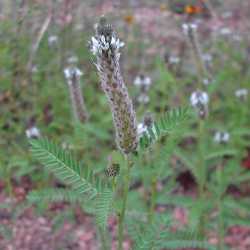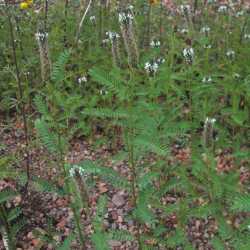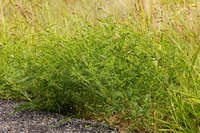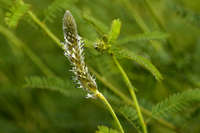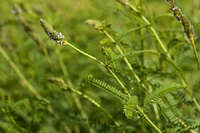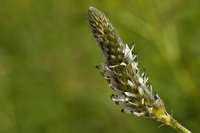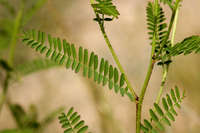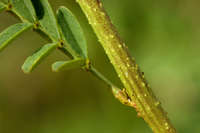On September 11, 1924, Mrs. Harry Bucklin of Brazil sent me a specimen which was collected at her summer home located in section 24 about 6 miles northeast of Brazil, Clay County. She wrote: "Frequent along the roadside and in an adjoining fallow field." I found the colony still persisting in 1934. No doubt introduced in seed of some kind since the farm is located on a little used road and not near a railroad.
Duration: Annual
Nativity: Native
Lifeform: Forb/Herb
General: Annual herb, 15-120 cm tall, from a slender taproot; stems erect, slender to robust, glabrous below the inflorescence.
Leaves: Alternate and pinnately compound, 2-10 cm long, with 21-35 leaflets per leaf (leaves on smaller branchlets may have fewer leaflets); leaflets 3-12 mm long, oblong-to obovate, glabrous; lower leaf surface gland-dotted and lighter green than upper surface.
Flowers: White to blue or pink-purple, in cylindric spikes, 2-8 cm long and about 1 cm wide, at branch tips; flowers about 5 mm long, with pea-flower morphology (papilionaceous), with a wide upper petal called the banner, two smaller lateral petals called the wings, and a boat-shaped lower petal called the keel which contains the style and stamens. Petals milky white to bluish-purple, almost blue, or rose-pink; sepals 5, abundantly silky-pilose, united at the base into a tube 3 mm long, this topped with 5 narrow teeth about 3 mm long.
Fruits: Pod hairy near the top, small, and contained within the persistent hairy calyx; containing 1 or 2 seeds.
Ecology: Found on roadsides, farm fields, along irrigation ditches, and other disturbed habitats, from 4,000-7,500 ft (1219-2286 m); flowers July-September.
Distribution: WI to ND, south to TX, NM, AZ, and MEX; also in S. Amer.
Notes: Look for this slender annual Dalea along roadsides. It is distinguished from other annual Dalea spp by this combination of traits: pinnately compound leaves with 6-20 pairs of leaflets; leaflets with rounded to truncate tips (not mucronate-tipped, or coming to a distnct, abrupt point); and flowers with hairy calyx tubes. The flower color is generally whitish with a tinge of blue or purple.
Ethnobotany: Unknown
Etymology: Dalea is named for Samuel Dale (1659-1739) an English physician and botanist; leporina means spotted, probably alluding to the gland-dotted leaves.
Editor: AHazelton 2017
Erect, leafy annual 3-10(-15) dm, simple to much branched, glabrous below the infl; lfls mostly 15-35+, oblong to oblanceolate or obovate, 3-12 mm; spikes erect, dense, 1.5-8 cm; bracts caducous, ovate to lance-acuminate or caudate; fls of sect. Dalea, white or anthocyanic, 5-7 mm; cal very villous, its subulate lobes mostly shorter than the tube, erect in fr; stamens 9 or 10; anthers shortly exserted; fr 2.5-3 mm; 2n=14. Prairies and open woods, or in disturbed sites; widespread in Latin Amer., n. to N.D., Minn., and Ind., and occasionally adventive farther e. June-Aug. (D. alopecuroides; Parosela a.)
Gleason, Henry A. & Cronquist, Arthur J. 1991. Manual of vascular plants of northeastern United States and adjacent Canada. lxxv + 910 pp.
©The New York Botanical Garden. All rights reserved. Used by permission.



